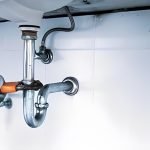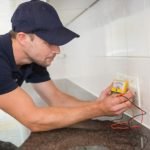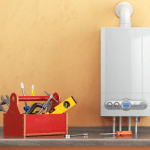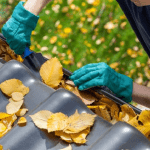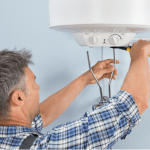
Shorter days? Check. Ice dams on your roof? Check.
Drafty interiors? Double check. Yep, we’re headed into winter, all right.
Although mesmerizing with its snow-covered landscapes, winter can wreak havoc on your home if you’re unprepared. Your roof may start leaking, you might start seeing frost on your windows, and your utility bills will probably start going through the roof.
So, before you cozy up with a mug of hot chocolate and turn your home into a hermitage until spring, take some time to follow these maintenance tips. A little preparation now can save you a lot of shivers (and money) later.
1. Prepare Your Flooring
Did you know hardwood or vinyl flooring isn’t as resistant to moisture as tile? Moisture can cause the hardwood to warp and the vinyl to peel, so if you have either of these types of flooring, take extra care to prevent water and snow from tracking in. Do this by placing mats at all exterior doors leading into your home. If you can’t run to the store, use old towels or rugs.
However, carpeting is your best friend if you want to prevent heat loss from the floor. It provides insulation and can help keep your home feeling warm even on the coldest days. Just be sure to vacuum regularly to prevent dirt and dust from settling in and grinding down the fibers.
You can also hire professionals for an annual carpet cleanse to remove deep-seated dirt, dust, or grime. When asked, several homeowners confessed that Eco’s did a good job with their carpets.
2. Inspect Your Roof
Unsurprisingly, the most exposed part of your home during winter is your roof. From hail and wind damage to the formation of ice dams, your roof takes a beating during the colder months.
It can cause the ridges and rakes (the slanted edges along your roof) to loosen and pull away from the main body of your roof. And, worse, if the ice dams aren’t removed, they can cause water to pool and seep under your shingles and into your home.
Therefore, it’s essential to inspect your roof before winter hits. Look for any loose or missing shingles and any cracks or holes. If you see any damage, repair it before the snow and ice start falling.
3. Clean Your Gutters and Downspouts
Your gutters and downspouts are crucial in keeping your roof in top condition. They help to redirect rainwater away from your roof and foundation.
If your gutters are clogged with leaves, they can’t do their job correctly. As a result, water will back up and eventually spill over your gutters’ sides. It can lead to problems, including roof leaks, interior water damage, and foundation issues.
So, clean your gutters and downspouts before winter arrives. You can take the DIY route or hire a professional. Either way, it’s worth the time and effort to avoid costly repairs down the road.
4. Trim Trees and Shrubs
Snow and ice can weigh down tree branches and shrubs, causing them to snap and break. If they fall on your roof, they can cause severe damage. They could also land on power lines or other homes, tripping out power or becoming a fire hazard. That is why trimming any overhanging branches before winter arrives is important. Plus, there’s a risk of your windows being smashed if heavy snow and ice accumulate on branches hanging over your home.
You don’t have to go crazy with the pruning – remove any dead or dying limbs and any hanging over your roof or power lines.
5. Seal Any Cracks or Gaps
One of the biggest culprits of high heating bills is air leakage. If your home has cracks or gaps, heat will escape, and cold air will find its way into your house. It’s a waste of energy and money.
Check around doors and windows for any gaps. Then, use caulk or weatherstripping to seal them up. You can also add door sweeps to your exterior doors to prevent further drafts.
Other areas to check for cracks are around electrical outlets, plumbing pipes, and ductwork. These are all potential sources of air leakage, so seal them up.
For more considerable changes, consider installing storm doors and windows. They’re designed to be more airtight than your regulars and can make a big difference in keeping your home warm during winter.
6. Prepare Your Heating System
Your heating system works hard all winter to keep your home toasty warm. Give it a little TLC before the cold weather hits to ensure it runs smoothly throughout.
First, have your furnace serviced by a professional. The experts will clean it, inspect it for any damage, and ensure it’s running properly. It will help prevent any costly repairs in the following months.
You should also change your furnace filter regularly – at least once every three months. A clean filter helps your furnace run more efficiently and prevents harmful particles from circulating through your home.
Finally, if you have a fireplace, ensure it’s in good working order. Clean out any ashes and soot that have built up over the summer. Inspect the chimney for any blockages or damage. And, if you’re using a wood-burning fireplace, stock up on firewood so you’re not left out in the cold.
7. Winterize Your Plumbing
Frozen pipes are one of the most common problems homeowners face during winter. If the water in the pipes starts freezing, it expands and causes the pipes to burst. That’s a big mess (and a hefty repair bill) you want to avoid.
So, to prevent frozen pipes, start by insulating any exposed piping. You can use pipe sleeves, foam insulation, or electrical tape.
In addition, let your faucets drip a little during cold weather. It can help prevent water in the pipes from freezing.
Draining all outdoor faucets and sprinklers is also a good idea. Turn off the water supply to these fixtures and open them up to allow any water left inside to drain out. Then, store them away for the winter.
Conclusion
Winters usually mean holiday cheer, hot cocoa by the fireplace, and quality family time. But they also bring snow, ice, and freezing temperatures. While cuddling in fleece blankets with a good book might sound ideal, there’s still some work to be done around the house. Use these winter home maintenance tips to prepare your home for the colder months and prevent any significant problems down the road.

